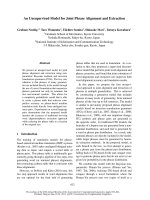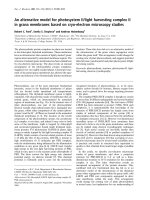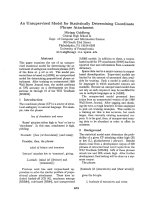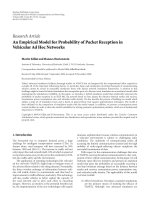An Intervention Model For Homeless Youth
Bạn đang xem bản rút gọn của tài liệu. Xem và tải ngay bản đầy đủ của tài liệu tại đây (635.53 KB, 12 trang )
Clinical Sociology Review
Volume 6 | Issue 1
Article 18
1-1-1988
An Intervention Model For Homeless Youth
Martin L. Abbott
Seattle Pacific University
Gerald F. Blake
Portland State University
Follow this and additional works at: />Recommended Citation
Abbott, Martin L. and Blake, Gerald F. (1988) "An Intervention Model For Homeless Youth," Clinical Sociology Review: Vol. 6: Iss. 1,
Article 18.
Available at: />
This Practice of Clinical Sociology is brought to you for free and open access by DigitalCommons@WayneState. It has been accepted for inclusion in
Clinical Sociology Review by an authorized administrator of DigitalCommons@WayneState.
An Intervention Model For Homeless
Youth*
Martin L. Abbott, Seattle Pacific University
Gerald F. Blake, Portland State University
ABSTRACT
Youth homelessness has become a more visible problem in recent years, and is
exacerbated by changes in the central city economy, schooling, and the family. This
article describes the "Street Youth Employment Program," a program designed by
sociological practitioners to intervene into the lives of homeless street youth through
a collaborative effort between a socio-medical clink and an urban university. Program
elements included (1) Stabilizing the living conditions of homeless youth, (2) Providing immediate part-time employment for participants on subsidized work projects, (3)
Ensuring participation by youth in program policy and operation, and (4) Providing
education and on-the-job training for youth.
Of the youth who participated in the program (N = 16), the majority (70%)
successfully moved away from living on the street to more stable involvement in work
or school. The limited success of the intervention was attributed primarily to the
linkage of meaningful employment with stable living arrangements, and attention to
medical and mental health needs. It was noted that direct job creation is a more
appropriate intervention strategy for homeless youth man pre-employment and job
readiness services alone.
Homelessness in American cities has become a increasingly serious and
visible problem in recent years. Many cities are facing serious problems in
attempting to manage the growing numbers of "traditional" poor and homeless
(i.e. older, skid row alcoholics, transients) as well as the increase in homeless
women and youth. Although some attribute an increase in the number of home*An earlier version of this paper (Gerald F. Blake, Martin L. Abbott, and Kathleen Oliver, “Targeting Social, Educational, and Employment Services for Homeless Youth") was presented at the
National Social Science Association meeting, Seattle, WA, Feb. 12–15, 1987 and appears in the
"Proceedings of the 1987 Seattle Conference" (Social Science Perspectives Journal, Vol. 1, No. 3).
148
AN INTERVENTION MODEL FOR HOMELESS YOUTH
149
less individuals to the deinstitutionalization of the mentally ill (Hope and
Young, 1984), this is a debated assumption (Snow, et al., 1986; Mowbray,
1985). The number of women on the streets has been increasing (e.g., see
Baxter and Hopper, 1982) and there is general agreement on the need for
structural (e.g., housing, employment, and a variety of social services) solutions
(e.g., see Sexton, 1986; Snow, et al., 1986; Mowbray, 1985). Kaufman (1984)
insists that a comprehensive policy, including provisions for a continuum of
services, is needed most in addressing homelessness (see also Stoner, 1984 on
this point).
The number of single, young adults living on the streets without resources
for survival has also increased significantly as a problem in the 1980s. This has
alarmed the public and overwhelmed skid row shelters and other social service
agencies who are attempting to respond to the homelessness problem (U.S.
Conference of Mayors, 1986). For youth who end up on the streets, homelessness is characterized by fear, exploitation and violence, and by the constant
attempt to find food and shelter (Young, et al., 1983; Wooden, 1976).
Factors Related to Youth Homelessness
The homeless youth problem comes at an unfortunate time in that most
U.S. cities are hard pressed to marshall the resources to meet the needs of an
increasing number of homeless youth. Cities' efforts to address youth homelessness are further handicapped by changes in the central city economy, the increasing number of school dropouts, and changes in family structure. As a
result, the number of urban youth who are homeless or living in poverty has
increased.
The Central City Economy
The youth labor market has suffered dramatically in recent years due to
fundamental changes in the central city economy. These changes are most
evident in the decline in manufacturing and production employment, which has
led to the elimination of numerous entry-level positions which were traditionally
occupied by youth (Kornblum and Williams, 1985; Waldinger and Bailey,
1985). Moreover, it has been suggested that remediation efforts, such as job
training programs for low income youth, are inferior and that, overall, there is
an inadequate supply of summer work opportunities (Kornblum and Williams,
1985). Polk (1984) asserts that these changes have resulted in a "new marginal
youth," that is, youth growing up in the inner city without the means or prospects of achieving self-sufficiency and stable employment.
150
CLINICAL SOCIOLOGY REVIEW/1988
School Dropouts
The literature suggests that most homeless youth have a history of poor
school performance and oftentimes withdraw or drop out of school before completion (e.g., see Burgess, et al., 1986; Schaffer and DeBlassie, 1984; Young
et al., 1983). The large number of homeless youth who have dropped out and
failed to acquire marketable skills further exacerbates the cities' ability to remedy their homeless situation.
Furthermore, there are changes occurring in the mission of the public school
which may create additional barriers for homeless youth. The "excellence"
movement in education is a case in point. The trend appears to be toward a
more rigid and disciplined approach to education, and focuses a greater amount
of school resources on the socially and economically advantaged student. This
creates the potential for leaving a significant number of disadvantaged youth
behind, therefore diminishing their career prospects (Bastain, et al., 1985; Apple, 1985; Smith and Hester, 1985). Observers claim it is the disadvantaged
student who will be unemployable and left with reduced prospects for competing
with college-bound peers for the highly skilled and well paying jobs in the
central city.
Family Structure
Another explanation for the increase in youth homelessness involves the
negative effects of dysfunctional families and changes in family structure and
stability. The increasing numbers of runaway, abused and abandoned youth
illustrate the role of the family in contributing to homelessness. Several recent
articles point to physical and/or sexual abuse at home as a contributing factor
to many runaway situations (Burgess, et al., 1986; Wiseberg, 1985). Other
studies note that some youth are abandoned or "thrown out" of the home
because they are unwanted (Adams, et al., 1985). In addition, Wooden (1976)
has cited crumbling family structure and increased family mobility as contributing to runaway behavior.
One result of these developments is a new form of urban poverty and
homelessness that affects young people between the ages of 15 and 21. This
form of poverty is characterized by restricted occupational mobility and disrupted family situations which, furthermore, increases the number of teenagers
and young adults who are unable to assume independent lifestyles, and who are
without the "natural" support systems traditionally provided by family members. The resulting lifestyle is marked by the following:
1. relatively long term homelessness
2. infrequent and sometimes hostile contact with a single natural parent or step
parent
AN INTERVENTION MODEL FOR HOMELESS YOUTH
151
3. moderately advanced stages of drag or alcohol abuse
4. relatively long periods of unemployment or marginal employment
5. and extended absence from formal schooling.
New integrative strategies clearly are needed to respond to the problem of
teenage homelessness, and the negative consequences that this marginal existence presents to American cities. Some of the more promising elements center
around combining a small range of services directed at stabilization, school
reintegration, part-time employment, and youth participation and empowerment
programming.
The Street Youth Employment Program
This is a case study of the collaborative effort between a socio-medical
clinic located in a central city and an urban university in order to design and
implement an intervention program for homeless youth. Specifically, the intervention attempted to identify the service and program elements that would
stabilize housing and health problems, and to target work experience and job
finding assistance for youth who desired to leave the streets. The overall goal
of the intervention was to identify the elements of a model that would enable
youth to move away from the street toward stable living and working conditions.
The intervention program was carried out in a major west coast city (1984
population 374,000) with an estimated homeless youth population of 300 -500
(MacRae, 1985; Donough, 1985). The social service agency involved in the
intervention operates a small program to assist homeless youth. The youth
program provides on-street outreach and operates a medical and prenatal clinic.
The program provides homeless youth with emergency food and clothing, and
operates a 90-day transitional housing program in cooperation with the county
and several single room occupancy (SRO) hotels. The youth program staff
provide counseling and case management, and assist youth in reentering school
or enrolling in alcohol and drug treatment programs. The agency had been
awarded short-term funding to supplement its existing medical and social services, and to target these services to homeless youth. University researchers
were initially contacted as consultants for grant activity, and later for summary
evaluation. The intervention model which resulted was called the Street Youth
Employment Program (SYEP), the purpose of which was to determine which
combination of strategies were most effective in dealing with youth living on
the streets.
One of the difficulties encountered in creating a program for homeless
youth is that, many times, the nature of their "street lifestyle" does not conform
to operational procedures of established agencies which serve youth. There are
a number of specific difficulties in working with street youth, which are related
152
CLINICAL SOCIOLOGY REVIEW/1988
to the structural conditions of homelessness itself. Table 1 lists several of the
most important of these difficulties the SYEP had to take into account in the
intervention program.
Table 1
Circumstances Surrounding Homeless Youth
• Homeless youth do not have access to shower facilities or a place to keep
clothing or other personal effects. Therefore they often look and dress in a
bizarre fashion.
• Homeless youth may have been living without conventional rates or
structure and, therefore, may find it difficult to move to a more structured
environment.
• Homeless youth often lack legal identification (i.e., birth certificate,
driver's license, etc.) and have few means to obtain them.
• Homeless youth are inaccessible to contact by social service agencies due
to the lack of a stable address and access to a telephone. Without access, to a
telephone, homeless youth have difficulty making medical, employment and
other contacts.
• Homeless youth are forced to live in the present, since they must constantly focus upon immediate survival needs. This makes any attempt to plan
for the future difficult.
• Existing pre-employment training and training services, such as resume
writing and job search skills, do not impact homeless youths' need for immediate food and shelter. Dealing drugs or prostitution may therefore take precedence over completing a job training program.
• Many homeless youth have chronic substance abuse problems, as well
as a range of emotional disorders.
• Very few homeless youth have obtained their high school diplomas and
may have serious academic deficiencies.
The Intervention Model
The intervention model was comprised of four interrelated strategies:
1. Stabilize the living conditions of homeless youth in order to reduce the
disruption to intervention efforts caused by the lack of secure shelter.
The first and most critical aspect of the intervention was to provide temporary shelter and to arrange for health screening for youth participants. Temporary shelter was provided by securing 90-day emergency housing vouchers from
the county Department of Social Services; these vouchers enabled the youth to
live in single room occupancy (SRO) hotels, the local YWCA, or other low
cost housing arrangements. In addition, the youth were assisted in establishing
eligibility for a range of social services including food stamps, medicaid, clothing allowances, and health screening and assessment.
AN INTERVENTION MODEL FOR HOMELESS YOUTH
153
2. Respond directly to homeless youths' need for regular employment in
order to assist them in establishing healthy, independent lifestyles.
Homeless youth have proven to be difficult clients for federally funded
private-industry council (PIC) programs to serve. Many of the young people
participating in the SYEP had previously been enrolled in PIC job readiness
classes only to fail or give up due to lack of progress in being placed in regular
employment. The Street Youth Employment Program was designed to provide
immediate, part-time employment for participants on subsidized work projects.
The youths worked 20 hours per week at the minimum wage on projects that
involved small teams of youth working under the supervision of program staff.
3. Involve homeless youth in decisions affecting program policy and operation so that they might gain greater control over their environment and exert
"ownership" over the intervention effort.
It was important for the intervention effort to enable participants to assert
greater control over events affecting their lives. The SYEP involved youth in
the planning of work projects and in setting program policy, thereby increasing
the youth's participation in workplace decision making. This resulted in the
creation of both a personnel policy for the program that established sanctions
for absences and repeated tardiness, and a grievance procedure designed to
resolve work-related conflicts. This form of participation was intended to increase ownership and investment in the program, and to develop a sense of
accomplishment and competence from the work projects.
4. Provide education and on-the-job training so that homeless youth can
learn marketable job skills and become reconnected to schooling.
This aspect of the intervention was designed to train participants in the skills
needed to complete the work projects. At the same time, youth were kept
eligible for future job choices by being encouraged to complete high school
credentials. On-the-job training was provided by project staff and a university
faculty member. University students assisted in the development of training
materials and other resources for use by program staff. The faculty member led
weekly group discussions on work-related subjects (e.g., "urban parks") and
facilitated project staff meetings. Participants who had not done so were encouraged to complete their high school education (through classes which met GED
requirements) while enrolled in the program.
The Participants
Sixteen homeless youth entered the program between October, 1985 and
March, 1986. This represented approximately 3–5 percent of the city's street
youth population. Program staff recruited participants through street outreach
efforts and by screening referrals from shelters in the downtown area. The
criteria used for selecting participants were: (1) the youths had to be between
154
CLINICAL SOCIOLOGY REVIEW/1988
the ages of 16–20; (2) they had to be living on the streets; (3) the youths had to
agree to participate in treatment services; and (4) they could not be runaways.
SYEP participants were comprised of five females and thirteen males. The age
distribution was five sixteen-year olds, three seventeen-year olds, and four each
at eighteen and nineteen years of age.
Youth participants varied in terms of the length of time they had been living
on the streets. Three of the youth had been on the street less than 30 days; five
had been on their own for one to six months; two for as long as one year; and
six for lengths of time ranging from two to three years. There were no significant
differences between males and females in terms of how long they had been
homeless.
Four of the youth (three females and one male) had been involved with
prostitution, ten had been sexually assaulted or physically abused while growing
up; one female was pregnant and three males had fathered children. Twelve of
the sixteen youth (ten males and two females) had contact with the juvenile
justice system; four had previously been psychiatrically hospitalized; and three
were taking psychotropic medications. All sixteen youth were current or past
alcohol or drug users; four were recovering alcoholics, three were recovering
drug addicts and four were still abusing drugs or alcohol but were currently in
treatment for these problems.
The educational backgrounds of the youth were similar in mat all had
dropped out of school before graduation. Five of the youth (three females and
two males) had since completed their GED certificates; five (two females and
three males) had gone as far as the eleventh grade; one to the tenth grade; two
each had gone as far as the eighth and ninth grade, and one had only a sixth
grade education.
The Work Projects
The Street Youth Employment Program was designed to employ youth at
work that had meaning to the youths and value to the broader community. In
addition, the program was planned to be small in scale, with a low supervisor-toyouth ratio. The youths worked in small teams (of 4–6 members each) with an
adult supervisor. The small group nature of the projects allowed youths to
actively participate in planning and policy setting for their work group.
The first work project was planned in cooperation with the City's Bureau
of Parks and Recreation. The project involved trail marking, clearing and construction on a section of forest trail that is part of a historic 40 mile loop of
walking and bicycle trails which encompass the entire city. The work crews
were supervised by SYEP staff and trained by Park Bureau staff in trail design,
landscaping and in elementary botany and plant identification. During the six-
AN INTERVENTION MODEL FOR HOMELESS YOUTH
155
months of SYEP operation, the youths completed 2½ miles of trail through steep
wooded areas and did landscaping and planting in the city's Arboretum.
The second project was a news and speakers bureau. The youths wrote and
produced a quarterly newsletter and made presentations before public audiences
on the problems of street life and related issues, such as drug and alcohol abuse,
street crime and family problems. The youths spoke before a wide variety of
community groups including church groups, social clubs and public school
classes.
The news and speakers bureau designed and produced six 8-page newsletters containing short stories, poems and articles authored by the youths. The
program approach, borrowed from the successful Foxfire concept (Wigginton,
1978), emphasized the development of writing, interviewing and small group
discussion skills. This approach was found to be successful in terms of helping
youth to gain an understanding and perspective on their life situations, and to
make plans for their future.
Outcomes of the Intervention
In very general terms, the small scale of SYEP allowed friendships to
develop, which many times extended outside of the program, thereby enabling
the youth to act as confidants and advisors to each other. Program participants
also assisted in educating new team members on program operation and policy.
Finally, the youth spent considerable time together when not on the job, often
times sharing meals and leisure time. These informal associations enabled the
youths to establish support systems that created a more positive environment in
which to address other social, medical or personal needs.
Of the sixteen youth who participated in SYEP, seven (four males and three
females) remained employed on projects after five months. This represents a
considerable amount of stability for youths who had been living on the streets
and who had very little work experience. Four of the sixteen youths (two males
and two females) moved on from the program after successfully applying for
full-time employment or returning to school; thus, eleven of the sixteen homeless youths succeeded in moving away from street life to more stable involvement in work or school.
The remaining five participants (all males) were not as successful by the
same criteria. Two youths worked for a few days, but were forced to leave the
program due to interruptions in their housing; one was terminated from the
program for fighting, one failed to comply with drug treatment, and one youth
was terminated from the program for being a fugitive from justice.
The limited success of the intervention was attributed to several factors: (1)
The combination of meaningful employment with stable living arrangements,
156
CLINICAL SOCIOLOGY REVIEW/1988
and attention to medical and mental health needs. (2) Recognition mat, although
most homeless youth are school dropouts, they are not incapable of learning.
The youth involved in SYEP were not opposed to learning, but had a history of
conflict with teachers and other school staff and, therefore, did not utilize the
conventional school to meet their needs. (3) The collaboration between social
service agencies and the university, which reflects the fact that complex community problems can be addressed by establishing organizational linkages in new
ways.
Conclusions
The major difficulty confronting successful strategies for homeless youth
is establishing an organizational network that can provide the specialized services that enable youth to move off of the streets. The reported intervention
program blended short and long term services to stabilize the youth, provided
education and job training and enabled the youth to perform useful and personally gratifying work. The SYEP brought together housing, food, health, education, and employment services in a way that created a positive support network
for program participants.
Homeless youth are similar to other young people in that "make work"
projects are generally performed poorly, while more challenging and socially
useful work is embraced and done well. Planning employment services for
homeless youth ought to take account of their need and desire to make a meaningful contribution to the broader community. In this context, direct job creating
is a more appropriate strategy for intervening with street youth than pre-employment and job readiness services alone. The latter services prepare youth for
employment, but do not directly provide a job. Street youth need both types of
services, with primary emphasis on direct employment.
In the final analysis, this paper is a report on the attempt by social scientists
to address a complex and persistent problem in urban areas. The intervention
model which emerged was the result of careful collaboration in response to the
crush of an immediate problem which has very large implications. The interventionists took into account the structural factors which often account for the
failure of street youth to enter the "mainstream" of the job market and a stable
lifestyle. By incorporating the natural abilities of the youth, and by allowing
them to contribute to something larger than themselves, this model reflected the
potential for a much larger effort with street youth.
It is the collaborative effort, which combined practitioners and researchers,
that underscores the importance of a clinical sociological approach. With the
overarching purpose of intervening for positive change, sociologists were engaged to provide a unique perspective on a thorny social problem. The linkage
of program elements to theoretical and empirical analyses of structural and
AN INTERVENTION MODEL FOR HOMELESS YOUTH
157
institutional determinants of homelessness produced a creative approach to
problem solving. In addition, sociologists were incorporated into practitioner
roles during the course of the intervention (as staff and youth trainers) and in
the evaluation process. (The major shortcoming in this respect is that the researchers were not incorporated earlier, which would have permitted a more
controlled intervention.) In these ways, sociological practitioners demonstrated
productive responses to the challenge of refining intervention procedures for
homeless youth.
This case study represents only one effort; however, the central elements
of the model call into question the factors which eventually lend themselves to
a growing social problem. What is needed (in addition to increased collaboration
between sociological practitioners and social service workers) is a comprehensive, national policy which deals with homeless street youth. A good deal of
work has been done with other street populations; however, this population of
young people may be, in the final analysis, the most important in terms of their
long-term impact on our society.
This paper was presented at the 1987 Sociological Practice Association
Annual Meeting, LaCrosse, Wi, June 4–7, 1987.
REFERENCES
Adams, Gerald R., Thomas Gullotta, and Mary Anne Clancy.
1985
"Homeless Adolescents: A Descriptive Study of Similarities and Differences Between Runaways and Throwaways." Adolescence, 20(79), Fall.
Apple, Michael W
1985
"Educational Reports and Economic Realities," in Altbach, P.G., G.P Kelly and
L. Weirs (eds.) Excellence in Education. Perspectives on Policy and Practice. Buffalo: Prometheus Books.
Bastian, Ann, et al.
1985
"Choosing Equality: The Case for Democratic Schooling," Social Policy, 15(4),
Spring.
Baxter, Ellen, and Kim Hopper
1982
"The New Mendicancy: Homeless in New York City." Amer. J. Orthopsychiat.,
52(3), July
Burgess, Ann Wolbert, Fr. Mark-David Janus, Arlene McCormack, and Judith Wood.
1986
"Canadian Runaways: Children in Turmoil, Running For Their Lives." Panel presentation: Symposium on Street Youth, sponsored by Covenant House, Toronto,
Canada Feb 10–12
Donough, Robert.
1985
"Juvenile Prostitution and Street Youth in Portland " Portland, OR. Tri-County
Youth Consortium, April-June.
Hope, Marjorie, and James Young
1984
"From Back Wards to Back Alleys. Deinstitutionalization and the Homeless " Urban and Social Change Review, 17(2), 7–11, Sum.
158
CLINICAL SOCIOLOGY REVIEW/1988
Kaufman, Nancy K.
1984
"Homelessness: A Comprehensive Policy Approach." Urban and Social Change
Review, 17(1), p. 21–26, Win.
Kornblum, William, and Terry Williams.
1985
Growing Up Poor, Boston: Lexington Books.
MacRae, Patti.
1985
"An Assessment of Employment Services for High Risk Youth in the Portland
Metropolitan Area." Portland, OR: Tri-County Youth Consortium, Sept.
Mowbray, Carol T.
1985
"Homelessness in America: Myths and Realities." Amer. J. Orthopsychiat., 55(1),
January.
Polk, Kenneth.
1984
"The New Marginal Youth," Crime and Delinquency, 30(3), July.
Schaffer, Bernie, and Richard R. DeBlassie
1984
"Adolescent Prostitution." Adolescence, Vol. XIX, No. 75, Fall.
Sexton, Patricia Cayo.
1986
"The Epidemic of Homelessness." Dissent, 33:137–40, Spring.
Smith, R.C., and Edward L. Hester.
1985
"Who's Looking Out for At Risk Youth." A Report to the Charles Stewart Mott
Foundation. MDC Corporation, Chapel Hill, NC. Fall.
Snow, David A., Susan G. Baker, Leon Anderson, and Michaei Martin.
1986
"The Myth of Pervasive Mental Illness Among the Homeless." Social Problems,
33(5), June.
Stoner, Madeleine R.
1984
"An Analysis of Public and Private Sector Provisions for Homeless People.'' Urban
and Social Change Review, 17(1), 3–8, Win.
U.S. Conference of Mayors.
1986
"The Growth of Hunger, Homelessness and Poverty in American Cities in 1985."
Washington, D.C.: U.S. Conference of Mayors.
Waldinger, Roger and Thommas Bailey.
1985
"The Youth Employment Problem in the World City," Social Policy, 16(1), Summer.
Weisberg, D. K.
1985
Children of the Night: A Study of Adolescent Prostitution. Lexington, Mass.: D.C.
Heath and Co.
Wigginton, Eliot.
1978
"The Foxfire Concept," in Pearl. A., Grant, J.D. and Wenk, E. (eds.) The Value
of Youth. Davis, CA: Dialogue Books.
Wooden, Kenneth.
1976
Weeping in the Playtime of Others. NY: McGraw-Hill.
Young, Robert L., Wayne Godfrey, Barbara Matthews, and Gerald R. Adams.
1983 “'Runaways: A Review of Negative Consequences.'' Family Relations, 32.









